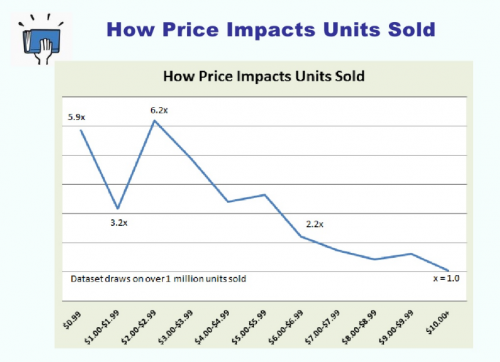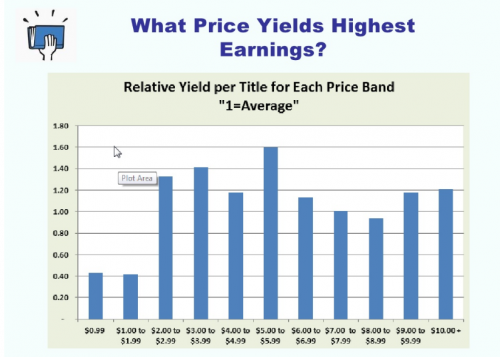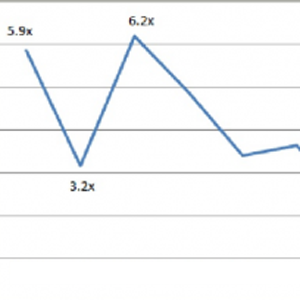Today is the final day that The Art of Freelance Blogging is available for nothing on Amazon. From tomorrow, the book will only move towards it’s full price of $9.99.
Perhaps this price will change, perhaps not. Pricing an eBook is not always easy. It’s not an exact science. Too cheap, and you undercut yourself, too high, and you may not get many sales. You need to review the price actively until you hit the sweet spot.
What is the Optimal Price for eBooks?
There isn’t an optimal price for all eBooks. It depends on so many factors. Genre, length of book, popularity of author etc. John Locke, famous for being the first author to sell 1 million eBooks on Amazon, sold most of his books for only $0.99 (he later revealed in a book that he did this with the help of paid reviews). Others have made millions by selling their books for over $10.
Nate Hoffelder wrote a great analysis of eBook pricing in an article entitled “There’s a $3 Sweet Spot For eBooks, But $6 eBooks Earn More“. The figures were provided by a Smashwords Slideshow posted around the same time.
The slides are over a year old, however I am sure that the results will be close to what we would see now. They found that free books were downloaded, on average, 100 times more than paid books. As you would expect, more eBooks were sold at lower price points. Interestingly, eBooks at $0.99 sold 5.9 times more than books at $10. Books between $1 and $1.99 only sold 3.2 times more, however books priced between $2 and $2.99 sold 6.2 times more.
If you are looking to sell the most books, $2.99 seems like the best price to sell your book.

The number of copies sold is less important than the money a book makes. Smashwords found that the most profitable price range was between $5 and $5.99. $3 to $3.99 was the next profitable and $2 to $2.99 was just a little behind. $10 books were the fourth most profitable price point.

These graphs help paint a picture of the buying habits of readers. The higher price points don’t earn as much because there are not enough people downloading the books. There doesn’t seem to be a huge difference in earnings between the higher price points. Additionally, I believe the sales results of non-fiction books would be very different to book sales as a whole. There’s a chance a higher book price may be the optimal point for earnings.
Finding the Sweet Spot of My eBook
I’ve given a lot of thought into the price of my new book. The price of a book depends a lot on where it is being sold. If I had sold the book on Clickbank, I would have had to price the book over $40 in order to give affiliates a commission of at least $20. Amazon is different. Books are more competitively priced, however authors get many more sales due to the volume of traffic Amazon receives.
Between $2.99 and $9.99, Amazon authors get a 70% commission (minus delivery fee). Non-fiction books can generally be sold for more than fiction books. $2.99 is a competitive price point whereas most of the books priced at $9.99 are also available in paperback (The Art of Freelance Blogging will be released in this format too).
In Make A Killing On Kindle, Michael Alvear suggests a few different ways to price an eBook at launch. One way is to start your book at $9.99 and then work your way down until you hit the optimal price point. Another way, is to start at $2.99 (for a fiction book) or $4.99 (for a non-fiction book) and move the price up to the optimal price.
It’s important to track the performance of each price point and record the earnings at each level. It is better to leave a book at a certain price level for a period of time so that stats are more accurate.
I was tweeting a few days ago with Shawn Welch, co-author of APE: Author, Publisher, Entrepreneur-How to Publish a Book. He noted that:
You don’t want to offer too much sales, or people will just expect the sale price to be the real price.
Undervaluing my work was something I am acutely aware of. Most of the books priced at $2.99 have less than 60 pages (some have half that). My book currently has around 352 pages in PDF form, which works out to be 288 pages on a Kindle book. So I could be underselling myself by selling a book that has 5 times as much content that other books. On the flip side, it could be what encourages people to buy my book over others.
Shawn suggested:
Settle on your final price. Offer at 50% off for launch (4 days), then offer at 25% off for the next 3 days, then full price.
I have decided to take his advice and try this strategy. I can then review the situation later. If I am not seeing many sales, I may put the book on sale temporarily and see how it affects sales. I can then work my way up until I find the optimal price.
I’m someone who doesn’t think twice of buying a good book at $9.99 if it provides a solution I need, however I know others thing differently. Many buyers will not purchase expensive books, and never will. I cannot concern myself with trying to please everyone, though I am concious of the fact that a higher price does not mean more money. If I can make more money selling the book at $2.99, $3.99 or $4.99; I’ll be happy to keep it at that price.
The last book I released on Amazon was only around 30 pages long, so I could not play around with the price much. This book is different. From what I have read, there is no one size fits all solution. It’s all about trial and error.
Michael Alvear and Shawn Welch both recommended a starting price point of $4.99 so I’m going to start at that price and then see how the book performs. Shawn recommended staying at this price for just a few days, however Michael suggested not changing the price point of a book until the book has moved up the rankings. Then he suggests changing the price point every few weeks.
Again, I don’t think either is right or wrong. I am going to place the book for sale on Saturday at $4.99 and then take it from there. Hopefully, I will see a good return. Regardless, I will keep you guys updated :)
I would love to hear from those of you who have released eBooks. What price point worked for you? What didn’t? Please leave a comment sharing your experience if you have time.
Kevin

